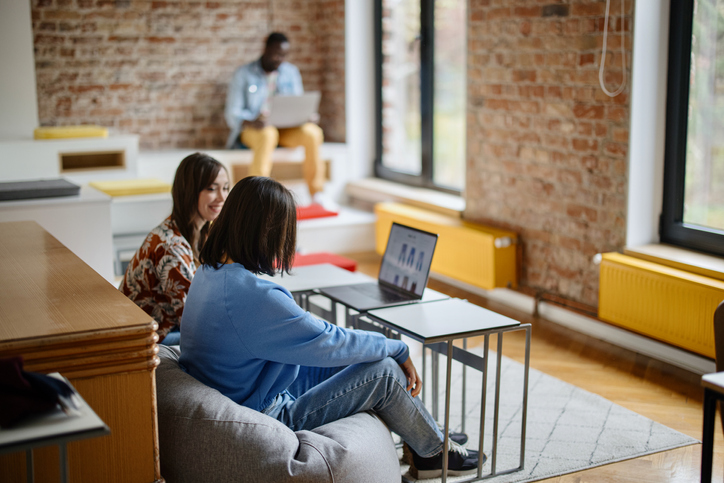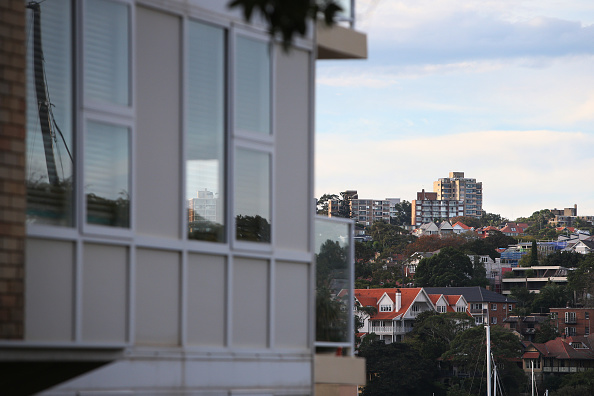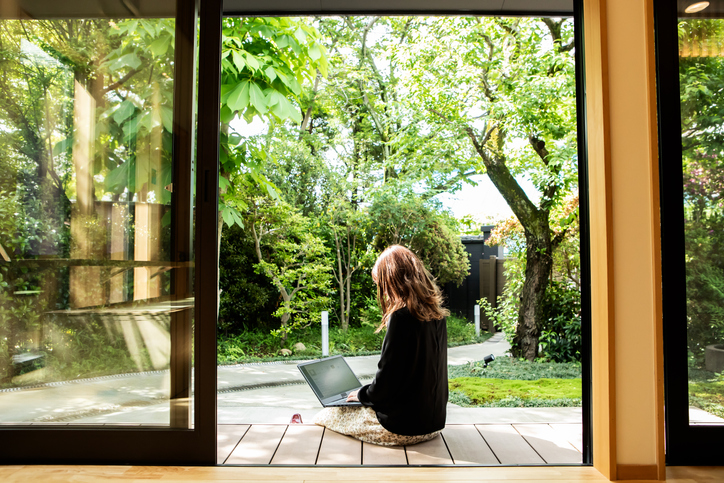How Hybrid Work Is Changing Offices of the Future
Architects and real-estate developers are pioneering concepts to entice workers who will permanently split their time between home and office. Here are the innovations you’ll see in coming years.
Workplaces that look like your living room; flexible, multi-use spaces; outdoor terraces. Today’s new hybrid work styles are reshaping the office buildings of tomorrow.
Leading architects and real-estate developers are pioneering concepts aimed at workers who are splitting their time between home and office, and they predict these innovations will become mainstream in the years to come.
The rethinking of office design comes as the return of employees to office buildings remains sluggish, reflecting new remote and hybrid workplace strategies. Workers’ office use on average is around 50% of pre-pandemic levels in 10 major U.S. cities monitored by Kastle Systems, which tracks security swipes into buildings. Employee engagement—a measure of how involved and enthusiastic workers are about their work and workplace—slipped in 2022 for a second consecutive year, according to a survey Gallup released in January.
Making the office a destination, with coordinated on-site days for collaboration, could go a long way in making workers feel more engaged, says Jim Harter, chief scientist for the workplace management practice at Gallup.
Architects are increasing access to the outdoors, even in skyscrapers. More office buildings will include “touchdown” spots where visiting employees can log in and work, says Annie Draper, a director who specializes in flexible office spaces at Hines, a global real-estate developer based in Houston. At Deutsche Bank’s new Americas headquarters in New York City, designed by architecture giant Gensler, trading floors include lockers for hybrid employees, to help avoid lugging equipment back and forth.
The latest changes in building architecture and design are more than temporary, reflexive responses to the pandemic, architects, developers and facilities managers say. Here’s a look at some of the trends that will transform the next generation of office buildings.
At Home at the Office
Your office is going to look a lot more like your living room (that is, if your living room has high-end decor). In a trend dubbed “resimercial,” short for residential commercial, some office designers are going for an at-home vibe with fewer desks and more couches, armchairs, stools and bistro tables—even fireplaces. The goal is to make offices less corporate-looking and more welcoming to employees who have become accustomed to working in the comfort of their homes.
The residential touches long used by gaming and tech companies will be showing up more broadly, says Talia Olson, interior designer at JPC Architects LLC in Bellevue, Wash. A recent client who wanted a complete office redo showed images that looked residential, with sofas, pillows, area rugs and lots of plants, Ms. Olson says. “A lot of this is getting people back into the office after we’ve been working from home for some time,” she says. “So why not design a space that has that feeling?”
Texas Tower, a 47-story office tower in downtown Houston by Hines that opened in December 2021, has a living-room feel in amenity areas furnished with sofas, armchairs, ottomans and coffee tables. Tenants include Hines, international law firm Vinson & Elkins LLP, and Cheniere Energy.
Lounge-like areas that in the past would have been reserved for executives will be available to all employees in the future, designers say. At the office headquarters Gensler designed for Marriott International Inc. in Bethesda, Md., opened in September 2022, a communal space on the 21st floor features a fireplace and cabinets with an inset TV screen. Nearby are sofas and seating at a high-top island where employees can work or meet with colleagues—with beverages at hand.
A Flexible Approach
New office designs reflect another lesson from pandemic remote work: Be flexible.
The office of tomorrow will have more open environments that accommodate varied working preferences, says Brett Williams, senior managing director, asset services leadership at commercial real-estate firm Cushman & Wakefield. These will include a mix of areas for individual focused work, private meetings and collaboration—often within steps of each other rather than on different floors as in the past.
Meeting rooms will be “less boardroom-style,” Mr. Williams says. Instead, they will be adaptable areas that can be changed to suit the specific needs of a meeting. To accommodate hybrid gatherings, they will increasingly be equipped with immersive technology that allows those on videoconference to feel as though they’re in the room, office planners say.
The new Marriott headquarters in Bethesda has an atrium-style area with a staircase that connects three floors. It could accommodate a thousand-person town hall, doing what a traditional auditorium would have done in the past, says Jordan Goldstein, co-firm managing principal at Gensler. “We’re seeing, in all the projects we have on the board, the need to think about how space can be flexible to bring people together in different ways—spaces that can convert, and be something that is comfortable as it is but then could easily handle greater capacity,” he says.
Equipment and instrumentation company NI Corp. (formerly National Instruments) is renovating its Austin headquarters to create a mix of large traditional conference rooms, small conference rooms, focus rooms and bookable areas of various sizes. Furniture is on casters to boost flexibility.
“What we discovered in designing this workplace of the future is that we need a workplace that has choices for all these work styles,” says Scott Strzinek, NI Corp.’s senior director of global facilities. The company had employees test the changes, designed by Gensler, in a portion of its building before going ahead with a renovation of 450,000 square feet, to be completed in 2024. NI Corp., which has 70 offices in 25 countries, plans to roll out the designs to other locations over the next few years.
A Breath of Fresh Air
Outdoor terraces, greenery and access to natural light and windows are a major feature in plans for new buildings. While Covid concerns spurred some of the open-air ideas, they are also aimed at replicating what many employees enjoyed when working from home.
“A huge priority for us is to add outdoor space with new developments vertically throughout and as many floors as possible, whether it’s a skyscraper or a shorter stack,” says Whitney Burns, global client strategy lead at developer Hines.
In the past if there was a terrace in the building, it was only for that one lucky company. “We want to make it more accessible for all tenants,” Ms. Burns says.
Architects see a move away from lining the perimeters of buildings with offices, a change that would allow more employees access to windows. One building Hines is developing will have “air porches” aimed to give a balcony feel in the absence of an actual deck. These areas, next to windows, are divided from the rest of the office with glass walls. The windows can open for fresh air, and the porches can be decorated with plants and lounge chairs.
At Lever House, a landmark 1951 office building on New York City’s Park Avenue, the third floor that historically would be leased to a tenant is being turned into an amenity floor for the entire building, featuring a 13,540-square-foot outdoor area with chairs and tables. “Now everyone in the building will be able to enjoy that outdoor space,” says Ben Friedland, vice chairman of CBRE Group Inc., which represents the building’s landlord. Use of the amenity floor—which also includes indoor co-working areas, conference rooms, dining rooms and a bar—is included in the rent. There are charges for food and beverages and to reserve conference rooms.
Some buildings will bring the outdoors inside. The London office of global design and consultancy Arcadis, opened in 2021, includes an airy “garden room” with natural light and plants. It is also a no-laptop zone, says Nilesh Parmar, the company’s business area director of places for North America. “This provides an area where people can relax, decompress and either enjoy time with their work colleagues or have a less formal business meeting.”
A Quiet Place
The libraries appearing in new office buildings have less to do with books and more with the “Quiet Please” sign.
“This idea of a need for more privacy is really driving a number of different space types that we may not have seen in the office before, because everyone works differently,” says Janet Pogue McLaurin, global director of workplace research and a principal at Gensler.
“To focus on my work” was the top reason employees said they wanted to come into the office in a Gensler survey of 2,000 employees in the U.S. conducted between June and August of last year, with 48% expressing that sentiment. This marked a shift from the previous year’s survey, where respondents placed greater importance on working in person with teams and colleagues.
“We have to create more spaces for people to do concentrated work, and that’s starting to drive quiet zones in an office, like those you might see on Amtrak [trains],” she says. “They may be tech-free zones or they may just be areas where everybody knows not to take a phone call.”
These efforts are also aimed at introverts and other workers who thrived working alone or in quiet surroundings during the pandemic and wondered if productivity would suffer in the return to the office. In addition to libraries and other no-noise zones, individual soundproof booths will be must-haves for office buildings, architects and developers say.
The London office of McCann advertising agency, completed in 2021, has an 800-square-foot library as well as designated quiet rooms where employees can retreat and recharge. Gensler, which designed the library, created an etiquette guide that stipulates no food and no group meetings. It has a large communal table, reference books and plush carpet that helps damp sound.
Hines plans to incorporate “head-down” areas in newer buildings that include rows of egg-shaped chairs that face outward away from the office. They provide visual privacy and noise blocking, says Ms. Burns of Hines. “When you’re sitting there, you feel like you have a private space.”
 Copyright 2020, Dow Jones & Company, Inc. All Rights Reserved Worldwide. LEARN MORE
Copyright 2020, Dow Jones & Company, Inc. All Rights Reserved Worldwide. LEARN MORE
This stylish family home combines a classic palette and finishes with a flexible floorplan
Just 55 minutes from Sydney, make this your creative getaway located in the majestic Hawkesbury region.
As Paris makes its final preparations for the Olympic games, its residents are busy with their own—packing their suitcases, confirming their reservations, and getting out of town.
Worried about the hordes of crowds and overall chaos the Olympics could bring, Parisians are fleeing the city in droves and inundating resort cities around the country. Hotels and holiday rentals in some of France’s most popular vacation destinations—from the French Riviera in the south to the beaches of Normandy in the north—say they are expecting massive crowds this year in advance of the Olympics. The games will run from July 26-Aug. 1.
“It’s already a major holiday season for us, and beyond that, we have the Olympics,” says Stéphane Personeni, general manager of the Lily of the Valley hotel in Saint Tropez. “People began booking early this year.”
Personeni’s hotel typically has no issues filling its rooms each summer—by May of each year, the luxury hotel typically finds itself completely booked out for the months of July and August. But this year, the 53-room hotel began filling up for summer reservations in February.
“We told our regular guests that everything—hotels, apartments, villas—are going to be hard to find this summer,” Personeni says. His neighbours around Saint Tropez say they’re similarly booked up.
As of March, the online marketplace Gens de Confiance (“Trusted People”), saw a 50% increase in reservations from Parisians seeking vacation rentals outside the capital during the Olympics.
Already, August is a popular vacation time for the French. With a minimum of five weeks of vacation mandated by law, many decide to take the entire month off, renting out villas in beachside destinations for longer periods.
But beyond the typical August travel, the Olympics are having a real impact, says Bertille Marchal, a spokesperson for Gens de Confiance.
“We’ve seen nearly three times more reservations for the dates of the Olympics than the following two weeks,” Marchal says. “The increase is definitely linked to the Olympic Games.”

Getty Images
According to the site, the most sought-out vacation destinations are Morbihan and Loire-Atlantique, a seaside region in the northwest; le Var, a coastal area within the southeast of France along the Côte d’Azur; and the island of Corsica in the Mediterranean.
Meanwhile, the Olympics haven’t necessarily been a boon to foreign tourism in the country. Many tourists who might have otherwise come to France are avoiding it this year in favour of other European capitals. In Paris, demand for stays at high-end hotels has collapsed, with bookings down 50% in July compared to last year, according to UMIH Prestige, which represents hotels charging at least €800 ($865) a night for rooms.
Earlier this year, high-end restaurants and concierges said the Olympics might even be an opportunity to score a hard-get-seat at the city’s fine dining.
In the Occitanie region in southwest France, the overall number of reservations this summer hasn’t changed much from last year, says Vincent Gare, president of the regional tourism committee there.
“But looking further at the numbers, we do see an increase in the clientele coming from the Paris region,” Gare told Le Figaro, noting that the increase in reservations has fallen directly on the dates of the Olympic games.
Michel Barré, a retiree living in Paris’s Le Marais neighbourhood, is one of those opting for the beach rather than the opening ceremony. In January, he booked a stay in Normandy for two weeks.
“Even though it’s a major European capital, Paris is still a small city—it’s a massive effort to host all of these events,” Barré says. “The Olympics are going to be a mess.”
More than anything, he just wants some calm after an event-filled summer in Paris, which just before the Olympics experienced the drama of a snap election called by Macron.
“It’s been a hectic summer here,” he says.

AFP via Getty Images
Parisians—Barré included—feel that the city, by over-catering to its tourists, is driving out many residents.
Parts of the Seine—usually one of the most popular summertime hangout spots —have been closed off for weeks as the city installs bleachers and Olympics signage. In certain neighbourhoods, residents will need to scan a QR code with police to access their own apartments. And from the Olympics to Sept. 8, Paris is nearly doubling the price of transit tickets from €2.15 to €4 per ride.
The city’s clear willingness to capitalise on its tourists has motivated some residents to do the same. In March, the number of active Airbnb listings in Paris reached an all-time high as hosts rushed to list their apartments. Listings grew 40% from the same time last year, according to the company.
With their regular clients taking off, Parisian restaurants and merchants are complaining that business is down.
“Are there any Parisians left in Paris?” Alaine Fontaine, president of the restaurant industry association, told the radio station Franceinfo on Sunday. “For the last three weeks, there haven’t been any here.”
Still, for all the talk of those leaving, there are plenty who have decided to stick around.
Jay Swanson, an American expat and YouTuber, can’t imagine leaving during the Olympics—he secured his tickets to see ping pong and volleyball last year. He’s also less concerned about the crowds and road closures than others, having just put together a series of videos explaining how to navigate Paris during the games.
“It’s been 100 years since the Games came to Paris; when else will we get a chance to host the world like this?” Swanson says. “So many Parisians are leaving and tourism is down, so not only will it be quiet but the only people left will be here for a party.”
This stylish family home combines a classic palette and finishes with a flexible floorplan
Just 55 minutes from Sydney, make this your creative getaway located in the majestic Hawkesbury region.






















